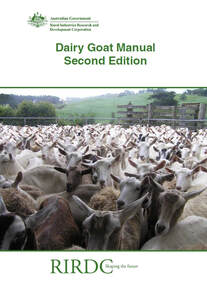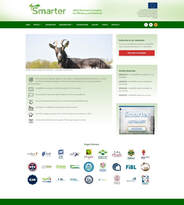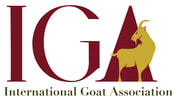 by Gaille Abud (IGA member) and Arthur Stubbs Foreword This revised edition of the “Dairy Goat Manual” was compiled as a guide to current recommended dairy goat farm management practices based on observations and information gained during the course of the RIRDC project “Farming and Marketing Goat and Sheep Milk Products”. Information contained in this Manual is provided as general advice only. For application to specific situations, professional advice should be sought. RIRDC and its research agents have taken all reasonable steps to ensure that the information in these publications is accurate at the time of publication. Readers should ensure that they make appropriate enquiries to determine whether new information is available on the particular subject matter. The project was funded from RIRDC Core Funds which are provided by the Australian Government. This report, an addition to RIRDC’s diverse range of over 1800 research publications, forms part of our New Animal Products R&D program, which aims to accelerate the development of viable new animal industries. Most of our publications are available for viewing, downloading or purchasing online through our website:
Peter O’Brien Managing Director Rural Industries Research and Development Corporation
5 Comments
Written by Gabriel Vicovan. Special thanks to Radu Răducu, Enciu Ana, and Vicovan Adriana for their assistance. Historic The High Prolificacy Breed Palas was formed over nine stages, during almost three decades by intricate crosses between the Romanov, Friesian, Finnish Landrace, Border Leicester, Ile de France and Palas Merino breeds. The desired type was obtained in 1989, and its genome consists of 39% genes from Romanov, 28% genes from Merinos, 16% genes from Friesian, 9% genes from Border Leicester, 6% genes from Ile de France, and 2% genes from Landrace Finnish. This population of sheep was reproductively isolated (CIR + 1,0) since 1989, and is bred at ICDCOC Palas Constanța. Breeding area In Dobrogea, at Research Development Institute for Sheep and Goats Breeding Palas – Constanța, there are 1,000 heads of sheep and 2,000 in another farm in the area. External (morphological) characteristics The body format of the breed is mesomorphic to dolichomorphic, with a fine, strong skeleton and correct aplomb. The head is broad, medium in size, and has a straight profile in ewes and slightly convex in rams. The ears are medium in size, worn laterally, and both sexes are hornless. The neck is suitably long, worn horizontally, and is well attached to the trunk; the trunk is long, with medium width and depth dimensions. The color of the wool is white, the coat has no colored fibers, and the hair on the face and limbs are white; the wool is semi-fine, some specimens having fine wool. The udder has a globular shape, of medium to large size, the nipples being suitably long, worn vertically or slightly laterally. Production characters
Reproductive characters Prolificacy primiparous, 136-140 % Multiparous, 150-160 % Using of the breed The new breed contributes to achieving a priority objective in the current economic context, namely, increasing meat production by producing three-stage meat hybrid lambs. The breed produces rams which, by mating with Merino-type sheep, determine the production of prolific F1 “halfbreed” hybrid ewes (in the first stage) and which, by mating with rams, from meat breeds, produce hybrids meat lambs (second stage). Written by Gabriel Vicovan Special thanks to Radu Răducu, Enciu Ana, and Vicovan Adriana for their assistance. Historic The breed was formed at the Research and Development Institute for Sheep and Goats Breeding Palas – Constanța between 1975 and 1987. They were developed by crossing East Friesian (imported from Germany) and Awassi (imported from Israel) breeds with the Merino de Palas breed, followed by isolation reproductive and selection to increase milk production. The breed was homologated in 2010. Currently, the Milk Breed Palas has in the genome 65% genes from two of the best milk breeds in the world – East Friesian and Awassi, with 27% of genes from Palas Merino breed raised in Dobrogea, and 8% genes from other breeds of minor importance. Breeding area In Dobrogea, at the Research and Development Institute for Sheep and Goats Breeding Palas – Constanța, there are 1,000 sheep, with 200 rams produced annually, to improve milk production in ewes farms located in the Dobrogea area. Conservation program The only genetic fund of the breed is found at the Research and Development Institute for Sheep and Goats Breeding Palas – Constanța. The population is structured in 12 ram families in the breeding season, proceeding the rotational mating between families. External (morphological) characteristics
The conformation is specific to dairy sheep. A long head with a convex profile is more pronounced in males. They are hornless, the ears are large, covered with short, thick white hairs, and are carried laterally with a tail well attached to the trunk. The chest is long and deep with a small sternum prominent, while the trunk is elongated, has a trapezoidal shape, and the spine is rectilinear. The croup is relatively broad, long, and straight; the tail is thin and long, covered with white, thick short hairs. The udder is well attached, has a globular shape, is sparsely haired, with long nipples, suitably thick, directed sideways and downwards. The body dimensions
Production characteristics
Reproductive characters Fecundity 92-97%; Prolificacy 117-128%  The first SMARTER annual meeting will be held in Edinburgh from 26th to 27th November 2019. One year after the start of the project, the meeting will aim to take stock of the work done during the first year, discuss the first results obtained and plan the actions to be carried out for the future. Stakeholders meetings and farm visits are planned from 28th to 29th November 2019. Did you know that IGA is part of the SMARTER Stakeholder Committee? Read more about it here. What is SMARTER? SMARTER stands for SMAll RuminanTs breeding for Efficiency and Resilience. Abstract
Background A clear association of amino acid variation in the prion protein gene (PRNP) with susceptibility and resistance to classical scrapie exists in sheep, but not in goats. In this study we examined DNA sequence variation in the PRNP of 149 animals from two scrapie-infected herds of Saanen dairy goats, and identified 6 non-synonymous variants in the coding region. Welfare, Health and Breeding Editors: Simões, João, Gutiérrez, Carlos  About this book This book explores the current trends and challenges of sustainable goat meat and milk production in different global contexts, providing valuable insights into this industry in adverse environments like mountain, semiarid and arid regions. It also includes contributions from international experts discussing goat reproduction, genetic diversity and improvement, as well topics such as animal health, welfare, socioeconomic aspects, and many other issues regarding the environmentally friendly and economically viable exploitation of goats. This is a highly informative book providing scientific insight for readers with an interest in sustainable agriculture and socio-economic aspects, as well as goat breed conservation, genetic diversity, and veterinary care. These subjects are complemented in a second volume providing a detailed description of more than 40 indigenous goat breeds and several ecotypes found in Asia, Africa, Europe, and America.  We would like to welcome our newest IGA institutional member, Federación Española de Asociaciones de Ganado Selecto (FEAGAS). FEAGAS was founded in 1982 as a technical and representative national forum for member organizations. They are the largest umbrella organization focused on livestock breeds in Spain. They represent 106 Spanish purebred livestock organizations, covering cattle, sheep, goats (14 goat breeders associations), pigs, horses, etc. Spain’s Ministry of Agriculture, Food and Environment and the Autonomous Communities has officially recognized them to manage and coordinate actions related to the herd books and the breeding of the livestock. Feeding & Breeding, February 21-22, 2017 
The “Jianzhou big-eared goat” is China’s newest meat goat variety. This marks the second successful cultivation of a new variety of meat goats in Sichuan Province, and the first Chinese meat goat since in 1998 following the country’s successful “Nanjiang yellow goat” variety in Sichuan Province.
Jianzhou big-eared goats evolved after 60 years of crosses between the British Nubian goat and the Jianyang local goat breed, including three cultivation stages: the introduction stage (hybrid form and hybrid population), progressive hybrid breeding stage, and transverse formation of fixed and breeding new varieties subculture stage. Jianzhou big-eared goats are 75% Nubian and 25% Jianyang. They are characterised by the following: |
IGA Blog
The International Goat Association promotes goat research and development for the benefit of humankind, to alleviate poverty, to promote prosperity and to improve the quality of life. Archives
May 2024
Categories
All
|
|
International Goat Association
2516 Millbrook Rd., Little Rock, AR72227 USA email: [email protected] -454-1641 |







 RSS Feed
RSS Feed